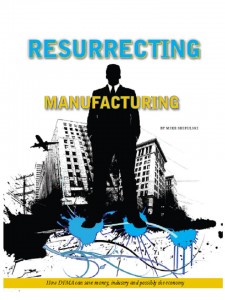Posts Tagged ‘Fix Manufacturing’
Growth for growth’s sake isn’t the answer
 Growth, as a strategy, is flawed. Draw a control volume around the planet and accelerate the growth engines: the natural conclusion – we run out of natural resources. Not if, when. Anything with a finite end condition is finite. That’s a rule. Because the world has finite resources, growth is finite.
Growth, as a strategy, is flawed. Draw a control volume around the planet and accelerate the growth engines: the natural conclusion – we run out of natural resources. Not if, when. Anything with a finite end condition is finite. That’s a rule. Because the world has finite resources, growth is finite.
Economists say growth is the only way. And the analysts say you’ve got to grow faster than their expectations or they’ll penalize your stock price. Economists say growth must be eternal and analysists say it’s never fast enough. The treadmill of growth keeps us accelerating, and we’re moving too fast to stop and ask why.
The idea behind growth is simple – with growth comes riches. As we’ve defined the system, when companies grow the people that own stock make more money. And in with our consumption mindset, more money means more stuff. Cutting right to it, company growth breeds bank account growth, which in turn breeds four cars, a 5,000 square foot primary residence, two vacation homes, closets full of too many clothes, three iPads, six laptops and five smart phones. And from this baseline, continued growth breeds more spiraling consumption.
If the consumption was curbed, what would happen to the riches?
Growth is better when it’s a result. Solve a societal problem and growth results, but instead of just filling the coffers, peoples’ lives get better. Make the water cleaner, people get healthier and you grow. And because you see the societal benefit, you feel better about yourself and your work.
Stock price increases when analysts think growth will increase. And increased stock price creates more wealth to fund more growth and fund more consumption. And, more consumption creates the right conditions for more growth.
What would happen if there was no growth?
If we were content with what we have, flat sales wouldn’t be a problem because we’d not need to consume more. And if we didn’t need to consume more we’d be happy with the money we make. No growth would be no problem.
Today, increased productivity is used to support increased sales. The incremental capacity (more units per hour) provides more products so more can be sold which creates growth. But in a “no growth” universe where growth is prohibited, instead of selling more, people would work less. Increase productivity by 25% and instead of working five days a week, everyone works four. That’s hard to imagine, but the numbers work. Instead of more money, we’d have more time.
Money isn’t finite, but time is. If we can learn to see time as something more valuable than money, maybe things can turn around. If we can see a growth in leisure time as some twisted form of consumption, maybe that would make it okay to spend more time doing the things we want to do.
Image credit — Michael
The Threshold Of Uncertainty
 Our threshold for uncertainty is too low.
Our threshold for uncertainty is too low.
Early in projects, even before the first prototype is up and running, you know what the product must do, what it will cost, and, most problematic, when you’ll be done. Independent of work content, level of newness, and workloads, there’s no uncertainty in your launch date. It’s etched in stone and the consequences are devastating.
A zero tolerance policy on uncertainty forces irrational behavior. As soon as possible, engineering gets something running in the lab, and then doesn’t want to change it because there’s no time. The prototype is almost impossible to build and is hypersensitive to normal process variation, but these issues are not addressed because there’s no time. Everyone agrees it’s important to fix it, and agrees to fix it after launch, but that never happens because the next project is already late before it starts. And the death cycle repeats project after project.
The root cause of this mess is the mistaken porting of manufacturing’s zero uncertainly mindset into design. The thinking goes like this – lean and Six Sigma have achieved magical success in manufacturing by eliminating uncertainty, so let’s do it in product design and achieve similar results. This is a fundamental mistake as the domains are fundamentally different.
In manufacturing the same product is made day-in and day-out – no uncertainty; in product design no two product development efforts are the same and there’s lots of stuff that’s done for the first time – uncertainty by definition. In manufacturing there’s a revision controlled engineering drawing that defines the right answer (the geometry and the material) – make it like the picture and it’s all good; in product design the material is chosen from many candidates and the geometry is created from scratch – the picture is created from nothing. By definition there’s more inherent uncertainty in product design, and to tighten the screws and fix the launch date at the start is inappropriate.
Design engineers must feel like there’s enough time to try new things because new products that provide new functionality require new technologies, new materials, and new geometries. With new comes inherent uncertainty, but there are ways to manage it.
To hold the timeline, give on the specification and cost. Design as fast as you can until you run out of time then launch. The product won’t work as well as you’d like and it will cost more than you’d like, but you’ll hit the schedule. A good way to do this is to de-feature a subassembly to reduce design time, and possibly reduce cost. Or, reuse a proven subassembly to reduce design time – take a hit in cost, but hit the timeline. The general idea – hold schedule but flex on performance and cost.
It feels like sacrilege to admit that something’s got to give, but it’s the truth. You’ve seen how it goes when you edict (in no uncertain terms) that the timeline will be met and there’ll be no give on performance and cost. It hasn’t worked, and it won’t – the inherent uncertainty of product design won’t let it.
Accept the uncertainty; be one with it; and manage it. It’s the only way.
Engineering Will Carry the Day
 Engineering is more important than manufacturing – without engineering there is nothing to make, and engineering is more important than marketing – without it there is nothing to market.
Engineering is more important than manufacturing – without engineering there is nothing to make, and engineering is more important than marketing – without it there is nothing to market.
If I could choose my competitive advantage, it would be an unreasonably strong engineering team.
Ideas have no value unless they’re morphed into winning products, and that’s what engineering does. Technology has no value unless it’s twisted into killer products. Guess who does that?
We have fully built out methodologies for marketing, finance, and general management, each with all the necessary logic and matching toolsets, and manufacturing has lean. But there is no such thing for engineering. Stress analysis or thermal modeling? Built a prototype or do more thinking? Plastic or aluminum? Use an existing technology or invent a new one? What new technology should be invented? Launch the new product as it stands or improve product robustness? How is product robustness improved? Will the new product meet the specification? How will you know? Will it hit the cost target? Will it be manufacturable? Good luck scripting all that.
A comprehensive, step-by-step program for engineering is not possible.
Lean says process drives process, but that’s not right. The product dictates to the factory, and engineers dictate the product. The factory looks as it does because the product demands it, and the product looks as it does because engineers said so.
I’d rather have a product that is difficult to make but works great rather than one that jumps together but works poorly.
And what of innovation? The rhetoric says everyone innovates, but that’s just a nice story that helps everyone feel good. Some innovations are more equal than others. The most important innovations create the killer products, and the most important innovators are the ones that create them – the engineers.
Engineering as a cost center is a race to the bottom; engineering as a market creator will set you free.
The only question: How are you going to create a magical engineering team that changes the game?
How To Create a Sea of Manufacturing Jobs
 It’s been a long slide from greatness for US manufacturing. It’s been downhill since the 70s – a multi-decade slide. Lately there’s a lot of hype about a manufacturing renaissance in the US – re-shoring, on-shoring, right-shoring. But the celebration misguided. A real, sustainable return to greatness will take decades, decades of single-minded focus, coordination, alignment and hard work – industry, government, and academia in it together for the long haul.
It’s been a long slide from greatness for US manufacturing. It’s been downhill since the 70s – a multi-decade slide. Lately there’s a lot of hype about a manufacturing renaissance in the US – re-shoring, on-shoring, right-shoring. But the celebration misguided. A real, sustainable return to greatness will take decades, decades of single-minded focus, coordination, alignment and hard work – industry, government, and academia in it together for the long haul.
To return to greatness, the number of new manufacturing jobs to be created is distressing. 100,000 new manufacturing jobs is paltry. And today there is a severe skills gap. Today there are unfilled manufacturing jobs because there’s no one to do the work. No one has the skills. With so many without jobs it sad. No, it’s a shame. And the manufacturing talent pipeline is dry – priming before filling. Creating a sea of new manufacturing jobs will be hard, but filling them will be harder. What can we do?
The first thing to do is make list of all the open manufacturing jobs and categorize them. Sort them by themes: by discipline, skills, experience, tools. Use the themes to create training programs, train people, and fill the open jobs. (Demonstrate coordinated work of government, industry, and academia.) Then, using the learning, repeat. Define themes of open manufacturing jobs, create training programs, train, and fill the jobs. After doing this several times there will be sufficient knowledge to predict needed skills and proactive training can begin. This cycle should continue for decades.
Now the tough parts – transcending our short time horizon and finding the money. Our time horizon is limited to the presidential election cycle – four years, but the manufacturing rebirth will take decades. Our four year time horizon prevents success. There needs to be a guiding force that maintains consistency of purpose – manufacturing resurgence – a consistency of purpose for decades. And the resurgence cannot require additional money. (There isn’t any.) So who has a long time horizon and money?
The DoD has both – the long term view (the military is not elected or appointed) and the money. (They buy a lot of stuff.) Before you call me a war hawk, this is simply a marriage of convenience. I wish there was, but there is no better option.
The DoD should pull together their biggest contractors (industry) and decree that the stuff they buy will have radically reduced cost signatures and teach them and their sub-tier folks how to get it done. No cost reduction, no contract. (There’s no reason military stuff should cost what it does, other than the DoD contractors don’t know how design things cost effectively.) The DoD should educate their contractors how to design products to reduce material cost, assembly time, supply chain complexity, and time to market and demand the suppliers. Then, demand they demonstrate the learning by designing the next generation stuff. (We mistakenly limit manufacturing to making, when, in fact, radical improvement is realized when we see manufacturing as designing and making.)
The DoD should increase its applied research at the expense of its basic research. They should fund applied research that solves real problems that result in reduced cost signatures, reduce total cost of ownership, and improved performance. Likely, they should fund technologies to improve engineering tools, technologies that make themselves energy independent and new materials. Once used in production-grade systems, the new technologies will spill into non-DoD world (broad industry application) and create new generation products and a sea of manufacturing jobs.
I think this is approach has a balanced time horizon – fill manufacturing jobs now and do the long term work to create millions of manufacturing jobs in the future.
Yes, the DoD is at the center of the approach. Yes, some have a problem with that. Yes, it’s a marriage of convenience. Yes, it requires coordination among DoD, industry, and academia. Yes, that’s almost impossible to imagine. Yes, it requires consistency of purpose over decades. And, yes, it’s the best way I know.
Top 10 signs your labor costs are too low
 Your purchasing manager was just fired due to skyrocketing shipping costs now that you build product in a country with low cost labor.
Your purchasing manager was just fired due to skyrocketing shipping costs now that you build product in a country with low cost labor.
You must hold a national press conference to explain how lead paint was put on your product by your supplier in a country with low cost labor.
You get up at 3:00 a.m. (for the fourth night in a row) to talk about a quality problem with a factory in a country with low cost labor.
You must cancel your lean projects because all your black belts are still solving quality problems in a country with low cost labor.
Though you have many half empty factories in your home country, you have a plan to build a new one in country with low cost labor.
Your best manufacturing leader just quit (via text message) because she wants to live with her family and not in a country with low cost labor.
Your purchasing manager’s brand new replacement was just fired because inventory carrying costs are through the roof now that you build product in a country with low cost labor.
You must find a landfill to bury three months of bad product now on a slow boat from a country with low cost labor.
Your new product launch is delayed because you have to tear down the machines and move them to a country with low cost labor.
The financial types that run your company are too far removed from the work so their only trick is to move it to a country with low cost labor.
How to Make an American Job Before It’s Too Late: Andy Grove
 An amazing article by Andy Grove, co-founder of Intel, that puts things in perspective. A country’s economy must be based on manufacturing and the jobs it creates. It’s not about the designing and developing. It’s about the manufacturing (and the jobs). End of story.
An amazing article by Andy Grove, co-founder of Intel, that puts things in perspective. A country’s economy must be based on manufacturing and the jobs it creates. It’s not about the designing and developing. It’s about the manufacturing (and the jobs). End of story.
This one’s worth the read.
Please pass this one around.
Cover Story IE Magazine – Resurrecting Manufacturing
 For too long we have praised financial enterprises for driving economic growth knowing full well that moving and repackaging financial vehicles does not create value and cannot provide sustainable growth. All the while, manufacturing as taken it on the chin with astronomical job losses, the thinnest capital investments and, most troubling, a general denigration of manufacturing as an institution and profession. However, we can get back to basics where sustainable economic growth is founded on the bedrock of value creation through manufacturing.
For too long we have praised financial enterprises for driving economic growth knowing full well that moving and repackaging financial vehicles does not create value and cannot provide sustainable growth. All the while, manufacturing as taken it on the chin with astronomical job losses, the thinnest capital investments and, most troubling, a general denigration of manufacturing as an institution and profession. However, we can get back to basics where sustainable economic growth is founded on the bedrock of value creation through manufacturing.
Continuing with the back-to-basics theme, manufacturing creates value when it combines raw materials and labor with thinking, which we call design, to create a product that sells for more than the cost to make it. The difference between cost (raw materials, labor) and price is profit. The market sets price and volume so manufacturing is left only with materials and labor to influence profit. At the most basic level, manufacturing must reduce materials and labor to increase profit. We can get no more basic than that. How do we use the simple fundamentals of reducing labor and material costs to resurrect U.S. manufacturing? We must change our designs to reduce costs using Design for Manufacturing and Assembly (DFMA).
The program is typically thought of as a well-defined toolbox used to design out product cost. However, this definition is too narrow. More broadly, DFMA is a methodology to change a design to reduce the cost of making parts while retaining product function. Systematic DFMA deployment is even broader; it is a business method that puts the business systems and infrastructures to deploy DFMA methods in place systematically across a company. In that way, it is similar to the better known business methodologies lean, Six Sigma and design for Six Sigma.
Click this link for the full story.
a
Click this link for information on Mike’s upcoming workshop on Systematic DFMA Deployment
Let’s Fix US Manufacturing Competitiveness
 (This post was published as an article. View the article as a .pdf or .htm.)
(This post was published as an article. View the article as a .pdf or .htm.)
Have we read enough, talked enough, circled, and delayed the issue enough to finally do something about the decline in US manufacturing? Are we afraid enough yet, after each quarterly government trade report, to undertake what is obvious as far as engineering goes? We have the technical know-how in US manufacturing to take away the offshoring advantage of cheap labor.We can design high labor costs out of most products and have elegant assemblies ripple profitably down US manufacturing lines—for export and domestic consumption.
“We have to reassign the product costs mistakenly
placed on manufacturing departments.”
 Mike Shipulski
Mike Shipulski